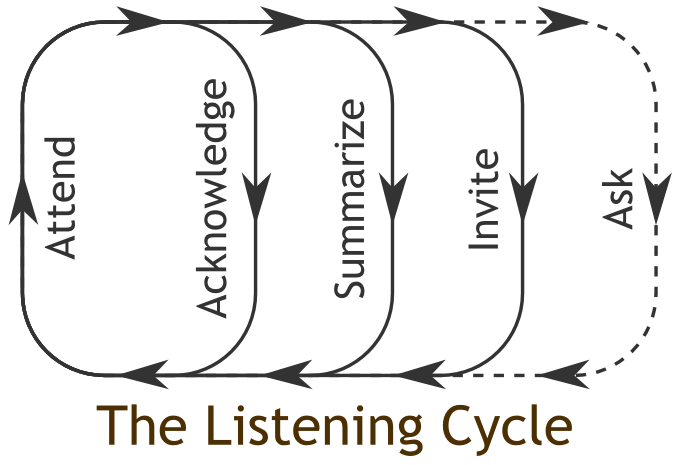Actively Listening using the Listening Cycle
This explanation follows in line after the Awareness Wheel.
Before we explain the Listening Cycle, here are some simple ground rules for communication in general:
Rules for the both of you:
- The speaker has the floor. Don’t cut off the speaker or finish his or her sentences.
- Share the floor (take turns)
- No problem solving
Speaker:
- Say “I” statements, Speak for self
- Share your feelings without putting down your friend
- Be specific and brief about your perceptions and feelings (2 - 3 sentences)
- Stop and allow your listener to paraphrase (if the paraphrase is not accurate, politely restate what was not heard the way you intended it.)
Listener:
- Choose a “Caring Connection” emotional brain state. You won’t be able to listen effectively if you are in a protective emotional state like “Anger”, “Fear” or “Panic”. See the Feeling Words List
- Say “You” statements providing a summary of what you heard the speaker say. (The speaker gets the focus)
- Don’t rebut (refute by evidence or argument) but instead paraphrase what the speaker said. Focus on the speaker’s message (Don’t offer your thoughts yet. Wait until you have the floor.)
- Invite the speaker to correct saying “Is that right?” or add more saying “Tell me more.”
Below is the Listening Cycle Diagram as presented by:
Miller, Sherod, Phyllis Miller, Elam W. Nunnally, and Daniel B. Wackman. Talking and Listening Together: Couple Communication I. Littleton, Colo.: Interpersonal Communication Programs, 1991. Print.

The Listening Cycle
The listener (from above) will actively respond to what the speaker is saying by following the listening cycle using the second person, “You” statements.
Attend
Give full attention to the speaker - Look, Listen, Track
Listen with your eyes and ears (check for congruency ie words, tone, facial expression and body language agree. See The Clear Communication Model). NB: you won’t be able to do this unless you make eye contact. Be present with your speaker.
Acknowledge the Speakers Experience
The best description is simply the idea that “you’re tracking with the speaker” (we often do this without thinking)
Can be through nods, “uh-uhs,” brief interpretive statements or exclamations
- “yeah” or “wow - that’s great” or “woah - that’s horrible”
- “I can see you’re really concerned”
- “You must be really excited”
Summarize to ensure accuracy
You may need to stop the speaker politely to give your summary
As in the floor exercise paraphrase especially focusing on feelings and wants
Don’t say “I understand.” Demonstrate that you understand by summarizing accurately.
Invite more information
(a step beyond acknowledging)
Help them to continue talking by saying
- Am I getting it?
- Tell me more about…
- Is there anything more you’d like me to know?
- What else would you like to add to that?
Ask open ended questions
Usually begin with who, what, when, where, or how [not why]
- I notice your frowning. What’s going on in you?
- What did you see, hear? Where? When?
- What do you think is going on?
- How do you feel?
- What do/did you want?
- Who will do what in the future to deal with the issue?
Don’t ask closed questions. Takes the focus off the speaker.
- I notice your frowning. Are you mad at me? (Focuses the attention on the listener.)
- Are you thinking your boss is mad at you? (Provides an interpretation.)
- Are you feeling mad or sad? (Limits the speaker to two choices.)
- Do you see your mistake? (This is not a question but an accusation.)
- Avoid asking “Why questions” (they’re usually disguised statements). The intent of most why questions is not to inquire but to persuade.
- Why don’t you want to do it my way? (disguised statement - I want you to do it my way.)
